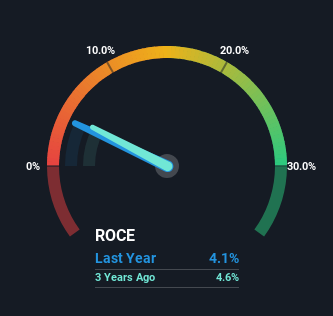- United Kingdom
- /
- Media
- /
- AIM:TMG
Mission Group (LON:TMG) Has Some Difficulty Using Its Capital Effectively
When researching a stock for investment, what can tell us that the company is in decline? Businesses in decline often have two underlying trends, firstly, a declining return on capital employed (ROCE) and a declining base of capital employed. Basically the company is earning less on its investments and it is also reducing its total assets. In light of that, from a first glance at Mission Group (LON:TMG), we've spotted some signs that it could be struggling, so let's investigate.
Return On Capital Employed (ROCE): What Is It?
For those that aren't sure what ROCE is, it measures the amount of pre-tax profits a company can generate from the capital employed in its business. To calculate this metric for Mission Group, this is the formula:
Return on Capital Employed = Earnings Before Interest and Tax (EBIT) ÷ (Total Assets - Current Liabilities)
0.041 = UK£4.7m ÷ (UK£168m - UK£55m) (Based on the trailing twelve months to June 2024).
Therefore, Mission Group has an ROCE of 4.1%. In absolute terms, that's a low return and it also under-performs the Media industry average of 11%.
View our latest analysis for Mission Group

Above you can see how the current ROCE for Mission Group compares to its prior returns on capital, but there's only so much you can tell from the past. If you're interested, you can view the analysts predictions in our free analyst report for Mission Group .
What The Trend Of ROCE Can Tell Us
We are a bit worried about the trend of returns on capital at Mission Group. About five years ago, returns on capital were 8.2%, however they're now substantially lower than that as we saw above. On top of that, it's worth noting that the amount of capital employed within the business has remained relatively steady. This combination can be indicative of a mature business that still has areas to deploy capital, but the returns received aren't as high due potentially to new competition or smaller margins. If these trends continue, we wouldn't expect Mission Group to turn into a multi-bagger.
The Bottom Line On Mission Group's ROCE
In the end, the trend of lower returns on the same amount of capital isn't typically an indication that we're looking at a growth stock. Long term shareholders who've owned the stock over the last five years have experienced a 66% depreciation in their investment, so it appears the market might not like these trends either. With underlying trends that aren't great in these areas, we'd consider looking elsewhere.
Like most companies, Mission Group does come with some risks, and we've found 1 warning sign that you should be aware of.
While Mission Group may not currently earn the highest returns, we've compiled a list of companies that currently earn more than 25% return on equity. Check out this free list here.
New: Manage All Your Stock Portfolios in One Place
We've created the ultimate portfolio companion for stock investors, and it's free.
• Connect an unlimited number of Portfolios and see your total in one currency
• Be alerted to new Warning Signs or Risks via email or mobile
• Track the Fair Value of your stocks
Have feedback on this article? Concerned about the content? Get in touch with us directly. Alternatively, email editorial-team (at) simplywallst.com.
This article by Simply Wall St is general in nature. We provide commentary based on historical data and analyst forecasts only using an unbiased methodology and our articles are not intended to be financial advice. It does not constitute a recommendation to buy or sell any stock, and does not take account of your objectives, or your financial situation. We aim to bring you long-term focused analysis driven by fundamental data. Note that our analysis may not factor in the latest price-sensitive company announcements or qualitative material. Simply Wall St has no position in any stocks mentioned.
About AIM:TMG
Mission Group
Operates as a collective of creative and martech agencies company in the United Kingdom, the United States, Asia, and rest of Europe.
Good value with adequate balance sheet.
Market Insights
Community Narratives



